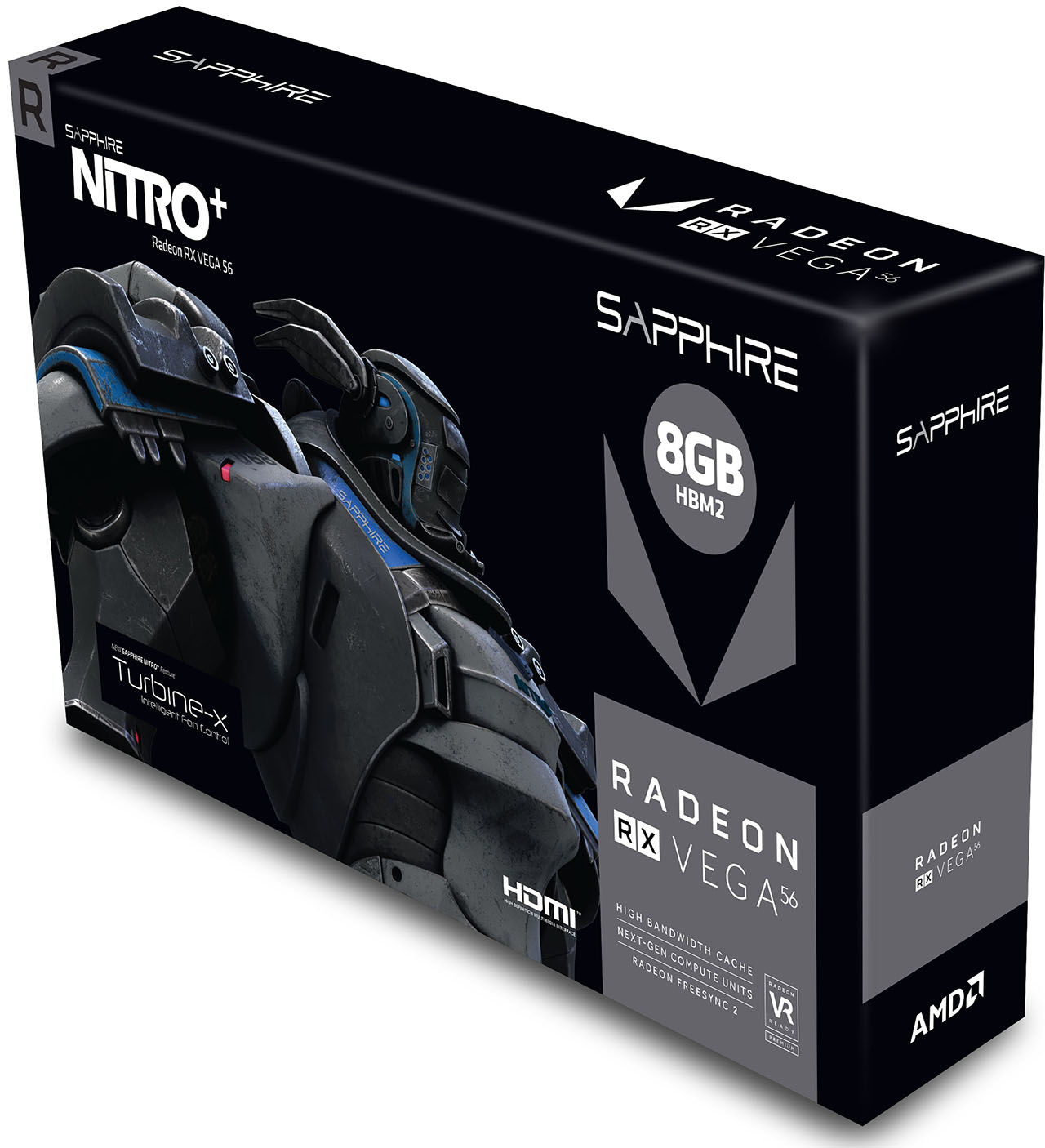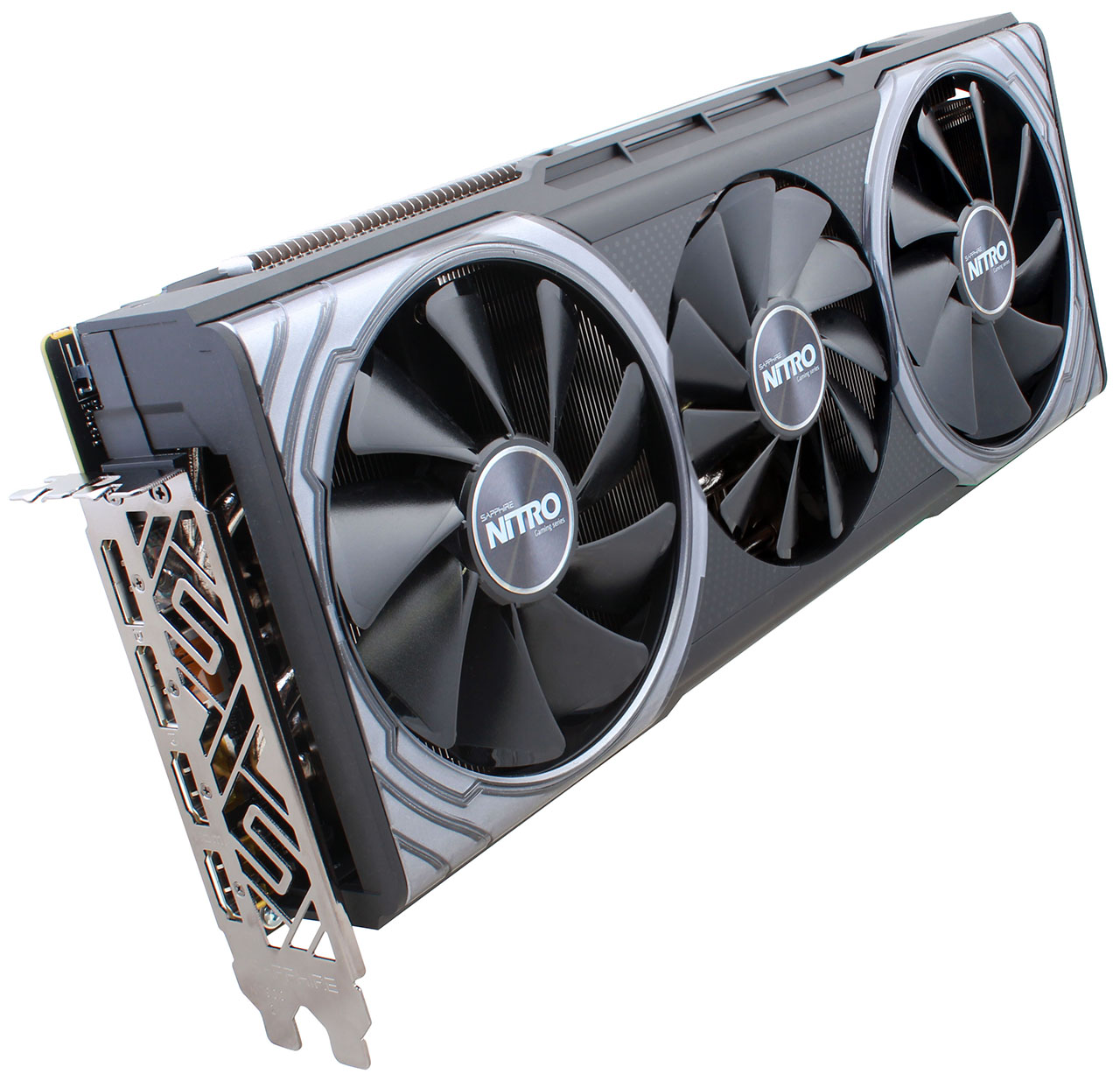Sapphire Nitro+ Radeon RX Vega 56 8GB Review: It's Time to Challenge Turing
Why you can trust Tom's Hardware
Conclusion
Without question, the Nitro+ RX Vega 56 8G is a premium implementation of AMD’s Radeon RX Vega 56. Its Tri-X Cooling system is massive, adding enough heft to the card’s design that a bundled support bracket is warranted. RGB lighting across the top and back looks classy without becoming gaudy. And downloadable TriXX NITRO Glow software facilitates complete control over the LEDs’ behavior, including turning them off completely for a more stealth look.
Sapphire’s thermal solution is, by far, this card’s most notable differentiator. Yes, it chews up three expansion slots on your motherboard and is incredibly heavy. But the two-part sink, connected by a number of heat pipes and topped with a trio of fans, is brutally effective. Sapphire’s Tri-X cooler enabled lower GPU temperatures than AMD’s reference Radeon RX 56 at slower fan speeds, all while running at a higher GPU voltage that made it possible to sustain more aggressive clock rates.
The price you pay for this opulence is two-fold. First, there’s the literal cost, which exceeds $700 from third-party vendors selling though Newegg. Then, there’s the markedly higher power consumption we measured. Under a normal gaming load, the Nitro+ RX Vega 56 8G uses almost 80W more than AMD’s reference version. That’s pretty obscene for a slight performance boost.
Another issue we discovered along the way was the Nitro+ RX Vega 56’s inductor whine. The high-pitched buzz proved most distracting on uncapped menu screens but was also audible during some gameplay as well. AMD’s reference cards suffer from the same artifact; the Nitro+ is simply louder when it’s affected.
In the end, it’d be difficult to recommend a Radeon RX Vega 56 that’s only available from no-name vendors at prices starting in the $700 range, especially since Newegg has the Nitro+ RX Vega 64 8G with two bundled games for $400. Our point here isn’t to pick at Sapphire's card, though. Rather, with Nvidia’s GeForce GTX 1660 Ti selling for $280 and up, we wanted to shine a light on Radeon RX Vega 56 boards available between $270 and $300. Although the Radeons use up a lot more power than the Turing-based GeForces, AMD’s solution is faster through our benchmark suite. And it’s especially superior in newer games that utilize DirectX 12.
While we’ll know soon enough whether AMD’s Navi design was worth waiting for, we can tell you now that Radeon RX Vega 56 outperforms the much newer GeForce GTX 1660 Ti at a very similar price point. It took nearly two years for Vega 10 to hit truly attractive price points. If you can find Radeon RX Vega 56 for less than $300, though, it’s a real winner.
MORE: Best Graphics Cards
Get Tom's Hardware's best news and in-depth reviews, straight to your inbox.
MORE: Desktop GPU Performance Hierarchy Table
MORE: All Graphics Content
-
MrN1ce9uy Sapphire's RX Vega 56 & 64 Nitro+ is my personal favorite all-time AIB partner design. Particularly, the Limited Edition with the vapor chamber. I'm glad this article made the distinction (y) Even the standard edition is one of my favorites.Reply -
lmille16 Can we color code the target card for future reviews? Tends to get lost on the chart.Reply -
ElectrO_90 Reply
Agree always a pain trying to read them tables for the one they are actually reviewing, as it doesn't stand out. Do as all the others do and what you used to do - makes it easier for everyone involved apart from your graphics artist who has to change the colourlmille16 said:Can we color code the target card for future reviews? Tends to get lost on the chart. -
King_V I have to say, given that it's the non-vapor-chamber version, the cooler is impressive - particularly with how low the temperatures stay with such a low fan RPM.Reply
Then again, the article used superlatives such as massive, and brutally effective, and that pretty much is my feeling on it.
In a perfect world, I'd like to see this with the fins oriented so that the rear vents could actually be useful, allowing some of the hot air to be expelled out of the case.
This isn't the card for me, were I looking to upgrade my son's PC - as I'd need to upgrade his PSU. At 2560x1080, I think running at the lower clocks, for a better performance/watt, as was mentioned in the analysis of the Vega 56 back when the first review was done, would be what I'd go for, and take advantage of things being uber-quiet.
Eh, basically, I wouldn't need the overclocking - but I'd love a model that was price-effective, and had such an amazing cooler. Major kudos to Sapphire on the cooling front. -
-Fran- I have the Vega64 version of this one, but not the one with the third 8pin connector... It can definitely use it, TBH, as it's one power hog of a card and incredibly silent nonetheless!Reply
And I think AMD still has a lot of issues with the Wattman thingy as it keeps crashing on me to the point where I just stopped bothering and just used the TRIXX fan profile and that's it.
Cheers! -
MrN1ce9uy I never liked Wattman. It did the opposite of what I wanted it to do more often than not.Reply -
Saieden Why are there no charts with undervolt and increased power limits? Surely you know by that the Vega cards push their clocks higher so long as they're within their thermal and power envelopes. You basically neglected the entire point of buying a non-reference Vega.Reply -
King_V Not specific to this card, but I do have to say that, for the tradeoff of much worse power/performance, and the fall of some Vega 56 models down to the $299 price level, Nvidia, through their pricing for their 1660Ti and 2060, has somehow managed to make the Vega 56 a contender in the price/performance arena.Reply
Granted, Vega 56's prices fell as a result of the release of the new Nvidia cards - but it seems to me that Nvidia's pricing model has made the Vega 56 viable. That strikes me as a hilarious bit of irony. -
MrN1ce9uy Even AMD's RX 590 pricing makes the RX Vega 56 a better choice. The only thing is RX Vega pricing is not consistent.Reply
I really wish I needed a GPU right now. I would buy this one (or two):
Video Card: Sapphire - Radeon RX VEGA 64 8 GB NITRO+ Video Card ($399.99 @ Newegg) -
-Fran- I think I got mine for £400, which is basically that price for the UK (including VAT). It was a killer deal and right on time when I got a WQHD 32" 144Hz beauty.Reply
Cheers!


